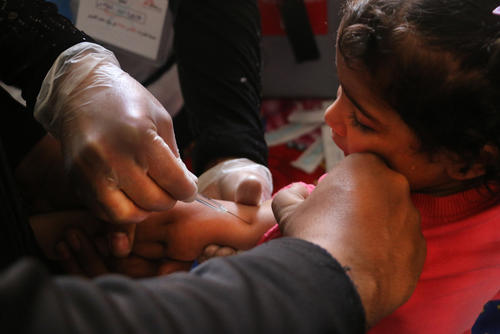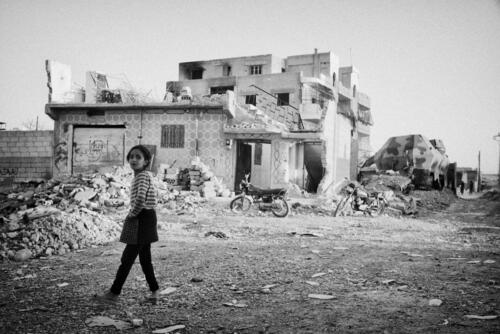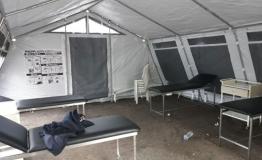Over the past two months, huge numbers of Syrians have been displaced from formerly besieged areas to northwest Syria, with more than 60,000 of them arriving in the governorate of Idlib and in northern Hama. Médecins Sans Frontières (MSF) is providing assistance throughout the area, and has strengthened the medical response in Qalaat al-Madiq in northern Hama, a location known as ‘zero point’ where new arrivals descend from buses. MSF supports the main hospital and the medical reception point in charge of triaging and treating the patients, but the overstretched capacity of medical facilities throughout the governorate, and the continued fighting and insecurity, represent a challenge for displaced people in Idlib and northern Hama.
A convoy of displaced people arrived at the ‘zero point’ after an 18-hour journey early on Saturday morning. Around 2,700 people descended from buses in the midst of torrential rain.
The MSF-supported hospital in Qalaat al-Madiq offered triage and primary healthcare to the new arrivals. “We have received some cases of undernourished children among the people arriving from North Homs,” said one doctor in the clinic. “We are providing primary care for people who need to be seen straight away, doing what we can to help the people arriving.”
The new arrivals spoke of their exhaustion after their nearly day-long journey. People were crowded into whatever covered spaces they could find to shelter from the rain as they waited to continue on to their new homes – a rented room for those with the means, a tent in one of the many camps scattered around the countryside for others, or further days or weeks of uncertainty for many.
In mid-April, following the Syrian government’s offensive to take over the enclave of East Ghouta, MSF increased its emergency response for tens of thousands of people displaced to northwestern Syria. Since then, several thousand more Syrians have been displaced from other areas of the country including from Southern Damascus and North Homs, to the governorate of Idlib.
In an earlier convoy that arrived on Friday morning carrying more than 2,800 people, 132 patients needed treatment. Eighteen of those were war-wounded, but the most common illnesses requiring treatment were unrelated to conflict, with conditions such as respiratory infections predominating.
“We have been providing assistance to internally displaced Syrians, as well as vulnerable residents, in Idlib and northern Hama for years, but these recent influxes represent a new challenge for us”, explains Sonja Van Osch, MSF Medical Coordinator. “In Idlib and northern Hama, nearly half the people are now internally displaced – some coming from elsewhere and some having fled fighting within Idlib governorate. We are talking about more than a million people who have had to move from their homes, many of them needing some sort of medical care. Hospitals and clinics are struggling to keep up.”
In Idlib and northern Hama, MSF is running a major burns and trauma hospital, conducting mobile clinics, distributing essential survival items, supporting more than 15 hospitals and clinics, as well as carrying out vaccination campaigns.
“At the Qalaat al-Madiq ‘zero point’, we have been increasing donations of key medical supplies, and provided a tent to triage and address the medical needs of newly displaced people, when they descend from buses”, adds Van Osch.
“We were already contributing to cover the staff salaries at this facility, but the workload has been rising sharply with the new arrivals, so we have started paying salaries for five additional nurses. We also support several hospitals in the area that, between them, cover a variety of medical services - maternity, surgery, internal medicine, peadiatric, and vaccination services,” Van Osch said. “We provide them with drugs, vaccines and other medical supplies, as well as giving advice when needed, covering essential running costs and contributing to the salaries of their staff. There are several aid organisations that have mobilised, but this assistance will need to be sustained as there are just so many people in such a vulnerable situation.”
Among the Syrians who recently arrived, some are medics that MSF had been supporting in formerly besieged areas. Like the patients they used to treat, and with whom they travelled to the north of the country, many have deep anxiety rather than relief about their current situation.
A medic from East Ghouta explains his fears about the ongoing fighting between armed groups in Idlib: “The current situation here is like sand in the desert: a small wind can produce a lot of dust. And it’s not good for me to be in the middle of that dust.”
Across northern Syria, MSF runs or directly supports six hospitals and seven health centres, and also operates six mobile clinic teams and six vaccination teams. MSF also provides distance support to around 25 health facilities countrywide, in areas where teams cannot be permanently present.
MSF’s activities in Syria do not include areas controlled by the Islamic State group since no assurances about safety and impartiality have been obtained from their leadership, nor can MSF work in government-controlled areas since MSF’s requests for permission to date has not resulted in any access. To ensure independence from political pressures, MSF receives no government funding for its work in Syria.





